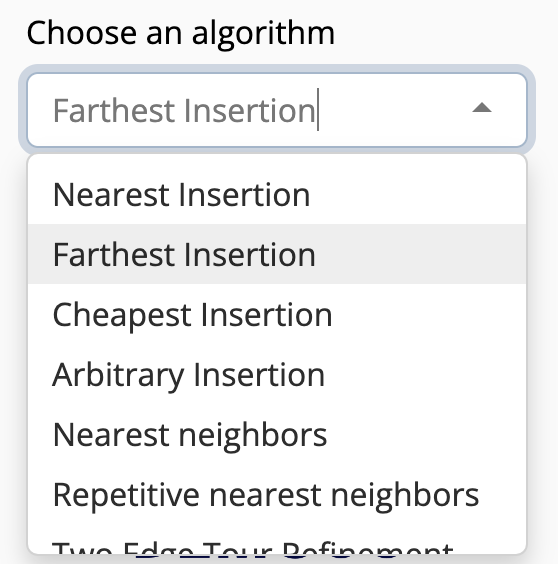The Traveling Salesperson Planner Shiny app demo lets you upload a file of destinations and download an efficiently ordered itinerary.
- View the app on Posit Connect
- Play with the code on Posit Cloud
To use the app:
-
Visit the app here. The app is hosted on Posit Connect, a hosting platform for data driven content. You can use Posit Connect to publish models, reports, etc. securely within your enterprise; or to deploy data products to your customers and manage access.
-
Select a starting location. Type in a city name followed by a state, or choose one from the drop down menu. This will be the location you will begin and end your journey at. The app recognizes 312 major North American cities.
 “Select location”
“Select location”
-
Upload a .csv file of destinations to visit. If you do not have a file, you can download one of the three suggested files and then upload it to the app.
 “Upload a file of
destinations”
“Upload a file of
destinations”
The file should contain a table that has a column named
latitudeand a column namedlongitude. Latitude, Lat, lat, Longitude, Long, and long are all acceptable spellings. Other columns are OK, but there should at least be a latitude and longitude column. If your table does not have these columns, the app will return this alert. “What the alert looks like”
“What the alert looks like”
-
Select an algorithm. There are multiple ways to solve the “Traveling Salesperson Problem.” The app will use R’s TSP package1 and whatever algorithm you select to order the destinations into a sensible itinerary.
After you select an algorithm, the app will build an itinerary and display a Download Itinerary button.
 “Select an algorithm”
“Select an algorithm”
-
Click Download Itinerary. The app will download a new version of your file. This versions reorders the rows in your original file to reflect the order in which you should visit the destinations. It also appends a column named “visit order”.
 “The Download Button”
“The Download Button”
The Traveling Salesperson Planner app is written in R with the Shiny package. Shiny makes it easy to create an interactive web app with only R code: you do not need to know HTML, CSS, JavaScript, or any web development skills. (Click here to learn about Shiny for Python).
This tutorial explains how to write a basic web app with Shiny. Like all Shiny apps, the Traveling Salesperson Planner app is composed of:
-
A user interface that collects input values and displays outputs:
# Define the Shiny UI layout ui <- page_sidebar( # Everything that appears in the UI )
-
A server function that tells R how to build outputs from input values:
# Define the Shiny server function server <- function(input, output) { # A list of definitions for outputs and intermediate objects, # as well as code to run to create those objects }
-
And a call to
shinyApp(), which brings the user interface and server function together.# Create the Shiny app shinyApp(ui = ui, server = server)
There are five unique things about the Traveling Salesperson Planner app:
-
It uses a theme from the bslib package to make the app look more visually appealing.
theme = bs_theme(bootswatch = "spacelab", success ="#86C7ED", base_font = "Open Sans", heading_font = "Open Sans")
-
It allows the user to upload a file to use as input with a fileInput widget.
fileInput("file", "Upload a CSV file of destinations:")
-
It checks the user’s file and provides a pop alert with the shinyalert package if anything looks amiss.
# helpers.R if (!valid) { shinyalert("Cannot create itinerary", "Your csv file should contain a column named latitude and a column named longitude.") }
-
It uses an interactive leaflet map to display locations on a map. You can learn more about using leaflet maps in Shiny apps here.
leafletOutput("map") -
It allows the user to download the results with a download button. This is a button that triggers a download handler.
# Render the download button in the UI if uploaded_data() exists output$downloadButtonUI <- renderUI({ req(uploaded_data()) downloadButton("downloadData", "Download Itinerary") }) # Create a download handler for the uploaded data output$downloadData <- downloadHandler( filename = function() { stub <- str_remove(input$file$name, "\\.csv$") paste0(stub, "_itinerary.csv") }, content = function(file) { data <- clean_for_download(itinerary()) write_csv(data, file) } )
Footnotes
-
Hahsler M, Hornik K (2007). “TSP - Infrastructure for the traveling salesperson problem.” Journal of Statistical Software, 23(2), 1-21. ISSN 1548-7660, doi:10.18637/jss.v023.i02 https://doi.org/10.18637/jss.v023.i02. ↩
